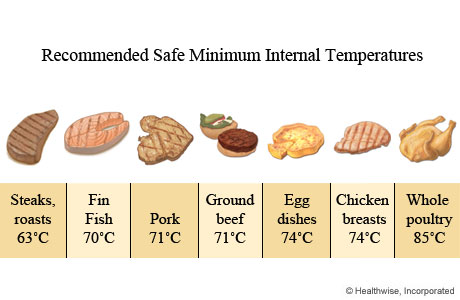Overview
It is important to cook foods at a safe temperature to avoid foodborne illness. The following picture shows you safe temperatures for a number of foods.

Adapted from Health Canada (2010). Safe Internal Cooking Temperatures. Available online: http://www.hc-sc.gc.ca/fn-an/securit/kitchen-cuisine/cook-temp-cuisson-….
When cooking foods:
- Use a clean meat thermometer to determine whether meat, poultry, or egg dishes are cooked to a safe temperature. The picture above shows specific safe temperatures.
- Bring sauces, gravies, and soups to a boil when reheating. Reheat other leftovers to at least 74°C (165°F).
- When using a microwave oven, cover the food container, and turn or stir the food to make sure it is heated evenly throughout. If the microwave does not have a turntable, rotate the dish by hand once or twice during cooking.
- Cook eggs until whites and yolks are firm.
- Do not eat raw or partially cooked eggs (including cookie dough), raw (unpasteurized) milk, cheeses made with raw milk, or unpasteurized juices.
- Do not eat undercooked hamburger, the main source of E. coli infection.
- Be aware of the risk of foodborne illness from raw fish (including sushi), clams, and oysters. Cook fish and shellfish until it is opaque and flakes easily with a fork.
- When eating out at a restaurant, make sure foods are thoroughly cooked and are served hot.
Credits
Current as of: March 2, 2023
Author: Healthwise Staff
Medical Review:
E. Gregory Thompson MD - Internal Medicine
Anne C. Poinier MD - Internal Medicine
Adam Husney MD - Family Medicine
W. David Colby IV MSc, MD, FRCPC - Infectious Disease
Current as of: March 2, 2023
Author: Healthwise Staff
Medical Review:E. Gregory Thompson MD - Internal Medicine & Anne C. Poinier MD - Internal Medicine & Adam Husney MD - Family Medicine & W. David Colby IV MSc, MD, FRCPC - Infectious Disease

